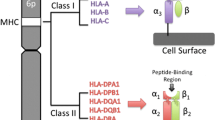Abstract
Over the past few years there has been increasing awareness of the importance of humoral mechanisms in the rejection of renal transplants. In this study we have monitored the development of antibodies directed against donor T and B lymphocytes using the sensitive flow cytometric technique. Forty-two cadaveric renal transplants were studied both before and for a maximum of 14 days after transplantation. Donor cells were separated from spleen on the day of transplantation and stored in liquid nitrogen until required. The dual colour flow cytometric assay was used to detect IgG or IgM directed againts donor T or B lymphocytes. Using AB sera as controls, results were expressed as relative median fluorescence (RMF) and then correlated with the clinical performance of the grafts. Significant associations were found between the incidence of donor-directed antibodies and the development of clinical rejection. The magnitude of the rise in antibody levels was also related to graft performance. In patients showing severe graft rejection, high levels of antibodies of the IgG class developed before the clinical diagnosis of rejection was made. The routine use of this test allows the prediction of impending severe rejection to be made and may have important implications for immunosuppressive therapy.
Similar content being viewed by others
References
Amos D, Bashir H, Boyle W, Mac-Queen M, Tiilikainen A (1969) A simple microcytotoxicity test. Transplantation 7: 220–223
Cook D, Terasaki P, Iwaki Y, Terashita G, Lau M (1987) An approach to reducing early kidney transplant failure by flow cytometry crossmatching. Clin Transplant 1: 253–256
Ende N, Williamson E (1968) Humoral antibodies and human renal homograft rejection. Am J Clin Pathol 49: 155–160
Fuller TC, Phelan D, Gebel H, Rodey GE (1982) Antigenic specificity of antibody reactive in the antiglobulinaugmented lymphocytotoxicity test. Transplantation 34: 24–29
Garovoy M, Rheinschmidt M, Bigos M, Perkins H, Colombe B, Feduska N, Salvatierra O (1983) Flow cytornetry analysis: a high technology crossmatch technique facilitating transplantation. Transplant Proc 15: 1939–1944
Huber C, Irschik E, Leiter E, Binz H, Niederwieser D, Spielberger M, Kathrein H, Schönitzer D, Margreiter R (1986) Use of donor-specific T-cell lines for monitoring of human allograft recipients. I. Demonstration of IgG binding to autologous TCL. Exp Cell Biol 54: 16–24
Iwaki Y, Terasaki PI (1987) Primary nonfunction in human cadaver kidney transplantation: evidence for hidden hyperacture rejection. Clin Transplant 1: 125
Iwaki Y, Cook D, Terasaki P, Lau M, Terashita G, Danovitch G, Fine R, Ettenger R, Mendez R, Kavalich A, Martin D, Soderblom R, Ward H, Berne T, Lieberman E, Strauss F (1987) Flow cytometry crossmatching in human cadaver kidney transplantation. Transplant Proc 19: 764–766
Johnson AH, Rossen RD, Butler WT (1992) Detection of alloantibodies using a sensitive antiglobulin microtoxicity test: identification of low levels of preformed antibodies in accelerated allograft rejection. Tissue Antigens 2: 215–216
Kissmeyer-Nielsen F, Olsen S, Petersen V, Fjeldborg O (1966) Hyperacute rejection of kidney allografts associated with pre-existing humoral antibodies against donor cells. Lancet II: 662–665
Manzler A (1968) Serum cytotoxin in human kidney transplant recipients. Transplantation 6: 787–792
Martin S, Dyer P, Mallick N, Gokal R, Harris R, Johnson R (1987) Posttransplant antidonor lymphocytotoxic antibody production in relation to graft outcome. Transplantation 44: 50–53
McPhaul J, Stastny P, Freeman R (1981) Specificities of antibodies eluted from human cadaveric renal allografts: multiple mechanisms of renal allograft injury. J Clin Invest 67: 1405–1414
Mittal K, Mickey M, Singal D, Terasaki P (1968) Serotyping for homotransplantation. XVIII: Refinement of microdroplet lymphocyte cytotoxicity test. Transplantation 6: 913–927
Patel R, Terasaki P (1969) Significance of the positive crossmatch test in kidney transplantation. N Engl J Med 280: 735–739
Scornik J, Salomon D, Lim P, Howard R, Pfaff W (1989) Posttransplant antidonor antibodies and graft rejection. Evaluation by two-color flow cytometry. Transplantation 47: 287–290
Shorter R, O'Kane H, Nava C, Hallenbeck G (1969) Lymphocytotoxins in sera from patients receiving renal allografts. Surgery 65: 793–796
Starzl T, Lerner R, Dixon F, Groth C, Brettschneider L, Terasaki P (1968) Schwartzman reaction after human renal homotransplantation. N Engl J Med 278: 642–648
Talbot D, Givan A, Shenton BK, Stratton A, Proud G, Taylor RMR (1988) The relevance of a more sensitive crossmatch assay to renal transplantation. Transplantation 47: 552–555
Terasaki PI, Bernoco P, Park MS, Ozturk G, Iwaki Y (1978) Microdroplet testing for HLA-A,-B,-C and-D antigens. Am J Clin Pathol 69: 103–120
Torlone N, Piazza A, Valeri M, Monaco P, Provenzani L, Poggi E, Adorno D, Casciani C (1992) Kidney transplant monitoring by anti donor specific antibodies. Transpl Int 5 [Suppl 1]: 676–678
Williams G, Hume D, Hudson R, Morris P, Kano K, Milgrom F (1968) “Hyperacute” renal-homograft rejection in man. N Engl J Med 279: 611–618
Author information
Authors and Affiliations
About this article
Cite this article
Al-Hussein, K.A., Shenton, B.K., Bell, A. et al. Characterization of donor-directed antibody class in the post-transplant period using flow cytometry in renal transplantation. Transplant Int 7, 182–189 (1994). https://doi.org/10.1007/BF00327085
Received:
Revised:
Accepted:
Issue Date:
DOI: https://doi.org/10.1007/BF00327085




